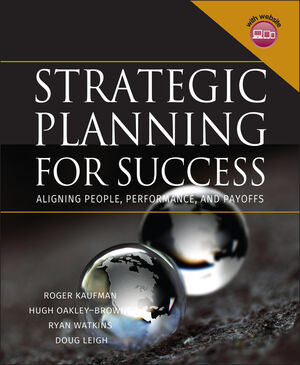Strategic Planning For Success: Aligning People, Performance, and PayoffsISBN: 978-0-7879-6503-7
Hardcover
416 pages
March 2003, Pfeiffer
 |
||||||
Preface.
Introduction.
1. BUSTING OLD PARADIGMS AND USING NEW ONES: DEFINING AND SHAPING OUR FUTURE.
Chapter Goals.
Today’s Paradigms.
The New Realities.
Ignoring the New Realities.
Paradigms That Work.
Create a Better Future.
Summary.
2. CRITICAL SUCCESS FACTORS FOR STRATEGIC THINKING THAT WORKS.
Chapter Goals.
Six Critical Success Factors for Strategic Thinking and Planning.
Is Change Strategic?
The Strategic Thinking and Planning Process.
The Consequences of Ignoring the Critical Success Factors.
3. SYSTEM (AND SYSTEMS) THINKING.
Chapter Goals.
The Organizational Elements Model.
Defining the Organizational Elements.
The Organizational Elements Describe a System.
The Organizational Elements—Useful Applications.
Planning from a Helicopter vs. Planning from the Ground.
4. PREPARING TO PLAN: ENSURING YOU DO THE RIGHT THING AND NOT SIMPLY DO THINGS RIGHT.
Chapter Goals.
The Strategic Planning Process.
Preparing to Plan.
Mega Level Visioning: Committing to the Longest View.
Assessing Resistance to Change.
Barriers—Common Mistakes Made by Strategic Planners.
5. ASSESSING NEEDS: DEFINING THE CRITICAL GAPS IN RESULTS . . .AND PUTTING THEM IN PRIORITY ORDER.
Chapter Goals.
Needs Assessment or Wants Assessment?
Defining Needs and Wants.
Needs Assessment Benefits.
The Organizational Elements.
The Needs Assessment Process.
Gathering the Data.
Data Gathering Methods.
Selecting Priority Needs.
Will the Needs Assessment Work?
6. SOLVING PROBLEMS: CLOSING THE PRIORITY GAPS.
Chapter Goals.
Solving Problems—An Overview.
Two Common Problem Solving Errors.
Errors in Formulating the Problem.
Simple Problem Solving.
Complex Problem Solving.
7. DEVELOPING SMARTER OBJECTIVES: THINKING AUDACIOUSLY, BEING AUDACIOUS, DELIVERING HIGH PAYOFF RESULTS.
Chapter Goals.
Why Objectives?
Categories of Objectives.
“Smarter” Criteria for High Impact Objectives.
Identify Key Result Areas.
Select Performance Indicators.
Detecting Non-Smarter Objectives.
Develop Mission Objectives.
Summary.
8. CREATING CHANGE: MAKING SURE THE CHANGE EFFORT REALLY BROUGHT ABOUT CHANGE.
Chapter Goals.
Creating and Managing the Change from Present Results to Desired Results.
Transition Management Plan.
The Paradox of Building Commitment Through Pain.
Define Key Roles for Change.
Develop Sponsorship.
Preparing Change Agents and Advocates.
Managing Resistance Effectively.
Force Field Analysis.
9. SCOPING AND SCANNING THE ORGANIZATION: WHAT MEANS WILL ACHIEVE THE HIGH PAYOFF RESULTS.
Chapter Goals.
Scoping and Scanning.
SWOT Analysis.
Analyzing the Business Logic.
The Relationships Among the Business Logics.
The Cultural Screen.
10. DELIVERING HIGH PAYOFF RESULTS.
High Payoff Results.
Fourteen Steps to Useful Results and Performance.
A General Problem Solving Process Model.
Avoiding Success.
Summary.
APPENDIX A: PARADIGM SHIFT FOR TEACHING/LEARNING.
APPENDIX B: A GLOSSARY AND CLASSIFICATION OF TERMS AND TOOLS.
APPENDIX C: A SUGGESTED CODE OF PROFESSIONAL CONDUCT FOR DEFINING AND DELIVERING HIGH PAYOFF RESULTS.
References.
Index.
About the Authors.
About the International Society for Performance Improvement.
How to Use the CD-ROM.



